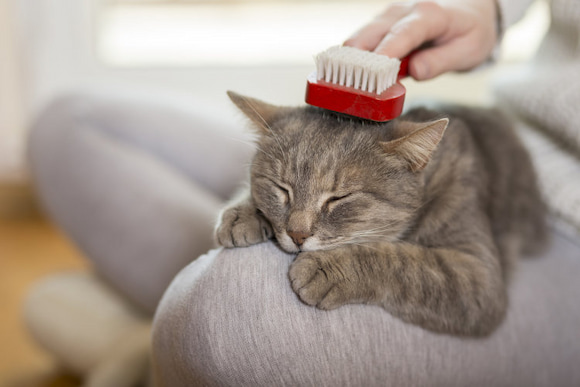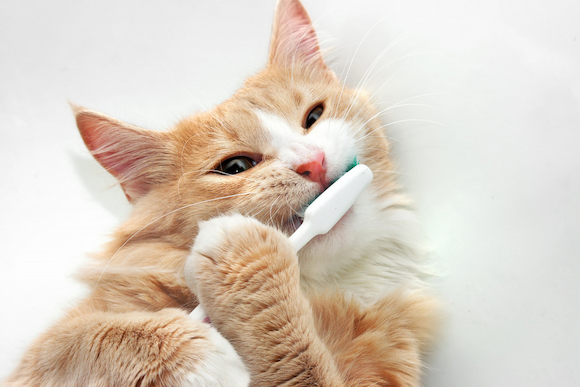As a proud cat owner, you probably know that cats are born with a strong cleanliness instinct and they obtain the habit of lick-cleaning themselves since their youngest age. This is due to cats having way more nerve endings in their noses than humans, which causes the strong urge to get clean and remove different odours from their fur to protect themselves from predators.
This is one of the main reasons why you should “give your cat a hand” into maintaining its own hygiene. We put together a couple of tips on how to keep up with your cat’s hygiene, from brushing and bathing to maintaining its dental health.
Brushing
Brushing your cat’s fur decreases hairballs and prevents the fur from getting tangled. Also, brushing your cat regularly means being alert of different ticks, wounds, lumps or any other skin problems. Aside from this, cats are known to enjoy brushing, so don’t hesitate to approach your kitten for a nice “massage”.
Choosing the Right Cat Supplies for Brushing
Once you visit your favourite pet supplier, you’ll notice that the market is overloaded with many different brushing products for cats. But this is due to different cat furs requiring different combs and brushes. For instance, short-haired cats should be brushed at least once a week with soft, silky brushes with finer bristles, so you don’t scratch their skin. Also, these brushes are suitable for newborn kittens, since their fur and skin are still fragile.
On the other hand, medium and long-haired cats require brushing on daily basis, using stronger combs with both coarse and fine teeth to prevent forming mats and tangles. If this is the case with your cat too, make sure you finish the brushing process by smoothing its fur with a soft bristle brush as the final step of the brushing process.
Also, if your little feline is afraid of those combs’ metal teeth and rough bristles of some brushes, make sure you replace them with rubber brushes. Not only they give a softer, more comfortable feeling but they’re also great for massaging the skin and stimulating even distribution of your cat’s natural fur oils.
How to Brush Your Cat Properly?
Introducing a brushing routine for your cat can be a daunting task, especially if you’re having a little kitten that isn’t that experienced in grooming itself. So first of all, make sure you create a peaceful ambience without any stimulations such as playing kids, other pets and different noises that can distract your cat. After you make sure that “the coast is clear”, kindly approach your kitten and start by making gentle strokes on its legs, and work your way up to its back and all its body parts. But, be careful with your kitten’s face, tummy and tail, since these are the most sensitive areas of cats’ bodies.
If you notice that your cat is not enjoying the brushing session or it resists it and tries to escape, don’t force it, but try to make short sessions by brushing only one section until your kitten becomes comfortable. When the brushing session ends, don’t forget to give your kitten some treats as a reward, so it learns to associate brushing with positive outcomes.
Bathing
Bathing your lovely feline is a way more overwhelming task than brushing it since it’s an unnatural feeling for cats due to their self-cleaning instinct. But even if you (and your cat) don’t think that baths are necessary, your mischievous kitten can sometimes get in touch with something dirty, sticky or smelly. That’s why baths shouldn’t be skipped.
Choosing the Right Cat Products for Bathing
If you thought that using human products for your cat’s occasional bathing adventures is convenient, know that it’s completely wrong and can dry out your kitten’s skin. This is due to humans and cats having different skin and hair PH levels, so make sure you get some proper cat stuff for bathing before you put your ball of fur in the bathtub.
For this purpose, it’s important to choose moisturizing and very light fragranced shampoos to retain your cat’s natural coat oils and prevent irritations. Also, after you rinse the shampoo, don’t forget to apply some specialized cat conditioner to make its fur looks shiny and well hydrated. While some of them should be rinsed as well, make sure you get a leave-in conditioner to cut the bathing process and stressing out your cat even more.
But cats can also be suffering from some skin conditions, such as bacterial infections, yeast infections and different skin allergies. In such cases, you should only use proper medical shampoos with antibacterial, antifungal and antipruritic properties. Such shampoos are specially formulated to remove, scale and degrease the skin as well as kill micro-organisms. This helps to keep the numbers of yeasts and bacteria at manageable levels and eliminates different allergens which can be trapped in the fur.
Also, be careful when choosing shampoos and different bathing cat stuff, since they’re way different than the ones for other pets and can be dangerous for your kitten’s health. This is why you should always carefully check the label to ensure that the product is intended and safe for cats.
How to Bathe Your Cat Properly?
Bathing is enough stressful for cats, so make sure you gently approach it one more time so you don’t startle your poor kitten even more. If needed, you can use another person to hold the cat or feed it with treats to keep it distracted.
Make sure you start by wetting your cat thoroughly with pleasantly warm water. After you do it, start applying shampoo and work it gently through its fur, avoiding its head, especially eyes and ears. When you make sure you’ve properly shampooed it, start by thoroughly rinsing it with warm water again. The next step is to apply conditioner by gently massaging it through your cat’s fur. If the conditioner you choose is a leave-in one, the bathing process is almost done, but if you choose a regular one, make sure you rinse it well before you let the cat out of the bathtub.
Finally, squeeze the excess water from your cat’s fur and wrap it in a soft, cotton towel to absorb the remaining water. And don’t forget to reward it with a treat once again, to show your appreciation of “collaborating” with you through the process.
Oral Hygiene
Maybe you never heard about this before, but your cat’s dental hygiene is equally important as yours since cats are also prone to plaque which can harden to become tartar and be the main cause for swellings, infections and different periodontal diseases. That’s why you should never skip brushing your cat’s teeth on daily basis.
Choosing the Right Dental Care Supplies for Cats
For maintaining your feline’s dental health, you only need two things- a specialized cat toothbrush and toothpaste. Starting from the toothbrush, not only they’re specially designed for your cat’s jaw, but they also come in different sizes depending on your cat’s size and breed. For smaller kittens, it’s always recommended to start brushing with a special finger cloth, so you get a better tactile sensation. Once you overcome the finger cloth, it’s time to get a specialised toothbrush. These brushes feature a smaller, angled head designed to reach every part of your cat’s mouth. Also, don’t forget to choose one with soft bristles, so you don’t harm your kitten’s fragile gums.
Talking about toothpaste for cats, unlike the usual mint and other different flavoured ones for humans, toothpaste for cats usually comes in food flavours such as chicken and beef. Aside from this, it’s always recommended to choose the ones containing pyrophosphates that control tartar and hydrated silica which is a mild abrasive that polishes your cat’s teeth. Vets also recommend getting a toothpaste that requires no rinsing to make the teeth brushing process more convenient and pleasant for both you and your cat.
How to Brush Your Cat’s Teeth
Regular brushing is the only way to maintain your kitten’s dental health, and that’s why you should brush its teeth on daily basis. This routine should be introduced slowly and very patiently since brushing teeth can also be a very stressful process for your feline.
So, start by applying some toothpaste on your finger, and let your cat lick it off so you can rub it on its gums. Then lift its lips to expose its front teeth, and start by gently brushing them. If your cat doesn’t mind, continue to brush, but if you notice that it resists don’t force it, but take a cuddling break instead and brush a few teeth at a time.





